Abstract
Nepetalactones belongs to the group of iridoid monoterpenoids, which are present in the aerial parts of nepeta plants. Nepetalactone is an attractant to feline animals causing euphoric effects, while it is a repellent to mosquitoes and cockroaches. It is also a pheromone for several insect aphid species. The main objective of this research was to study the electronic and spectral properties of nepetalactones. We investigated its structural properties using hybrid density-functional theory of B3LYP and WB97XD functional with the 6-311++G(d,p) basis set to optimize the geometry, and then computed the electronic structure, HOMO–LUMO, natural bond orbitals, molecular electronic potential and its contour map. We also obtained spectral signatures of NMR, IR and UV–Vis, and compared them with experimental data from the literature. The DFT study provided different electronic and spectral information that will be of value for further research on making new derivatives of nepetalactones for commercial purposes. Nepetalactones have a promising future in the development of novel mosquito repellents for the control of malaria and arboviral diseases.








Similar content being viewed by others
Data availability
Data are available upon request.
Code availability
Not applicable.
Abbreviations
- DFT:
-
Density-functional theory
- B3LYP:
-
Becke 3-parameter Lee–Yang–Parr exchange–correlation functional
- HOMO:
-
Highest occupied molecular orbital
- LUMO:
-
Lowest unoccupied molecular orbital
- NLO:
-
Non-linear optical
- NMR:
-
Nuclear magnetic resonance spectroscopy
- SCF:
-
Self consistent field
- GIAO:
-
Gauge‐including atomic orbital
- TMS:
-
Tetramethyl silane
- IR:
-
Infra-red spectroscopy
- UV–Vis:
-
Ultra-violet visible spectroscopy
- NBO:
-
Natural bond orbitals
- FMO:
-
Frontier molecular orbital
- NAC:
-
Natural atomic charges
- MEP:
-
Molecular electrostatic potential
- VEDA:
-
Visualization Energy Distribution Analysis
- PED:
-
Potential energy distribution
- ppm:
-
Parts per million
References
Aničić N, Matekalo D, Skorić M et al (2018) Trichome-specific and developmentally regulated biosynthesis of nepetalactones in leaves of cultivated Nepeta rtanjensis plants. Ind Crops Prod 117:347–358. https://doi.org/10.1016/j.indcrop.2018.03.019
Gkinis G, Bozin B, Mimica-Dukic N, Tzakou O (2010) Antioxidant activity of Nepeta nuda L. ssp. nuda essential oil rich in nepetalactones from Greece. J Med Food 13:1176–1181. https://doi.org/10.1089/jmf.2009.0218
Nestorović J, Mišić D, Šiler B et al (2010) Nepetalactone content in shoot cultures of three endemic Nepeta species and the evaluation of their antimicrobial activity. Fitoterapia 81:621–626. https://doi.org/10.1016/j.fitote.2010.03.007
Aydin S, Beis R, Öztürk Y et al (1998) Nepetalactone: a new opioid analgesic from Nepeta caesarea Boiss. J Pharm Pharmacol 50:813–817. https://doi.org/10.1111/j.2042-7158.1998.tb07145.x
Gkinis G, Ioannou E, Quesada A et al (2008) Parnapimarol and nepetaparnone from Nepeta parnassica. J Nat Prod 71:926–928. https://doi.org/10.1021/np800043b
Peterson CJ, Coats JR (2011) Catnip essential oil and its nepetalactone isomers as repellents for mosquitoes. In: ACS symposium series. pp 59–65
Sparks JT, Bohbot JD, Ristic M et al (2017) Chemosensory responses to the repellent nepeta essential oil and its major component nepetalactone by Aedes aegypti (Diptera: Culicidae), a vector of Zika virus. J Med Entomol. https://doi.org/10.1093/jme/tjx059
Stewart-Jones A, Dewhirst SY, Durrant L et al (2007) Structure, ratios and patterns of release in the sex pheromone of an aphid, Dysaphis plantaginea. J Exp Biol. https://doi.org/10.1242/jeb.009944
Zhu J, Cossé AA, Obrycki JJ et al (1999) Olfactory reactions of the twelve-spotted lady beetle, Coleomegilla maculata and the green lacewing, Chrysoperla carnea to semiochemicals released from their prey and host plant: electroantennogram and behavioral responses. J Chem Ecol. https://doi.org/10.1023/A:1020846212465
Zhou Q, Chen X, Dawei M (2010) Asymmetric, protecting-group-free total synthesis of (-)-englerin A. Angew Chem Int Ed 49:3513–3516. https://doi.org/10.1002/anie.201000888
Simmons D, Gobble C, Chickos J (2016) Vapor pressure and enthalpy of vaporization of oil of catnip by correlation gas chromatography. J Chem Thermodyn. https://doi.org/10.1016/j.jct.2015.09.005
Zhu JJ, Dunlap CA, Behle RW et al (2010) Repellency of a wax-based catnip-oil formulation against stable flies. J Agric Food Chem. https://doi.org/10.1021/jf102811k
Chauhan KR, Klun JA, Debboun M, Kramer M (2005) Feeding deterrent effects of catnip oil components compared with two synthetic amides against Aedes aegypti. J Med Entomol 42:643–646. https://doi.org/10.1603/0022-2585(2005)042[0643:FDEOCO]2.0.CO;2
Birkett MA, Hassanali A, Hoglund S et al (2011) Repellent activity of catmint, Nepeta cataria, and iridoid nepetalactone isomers against Afro-tropical mosquitoes, ixodid ticks and red poultry mites. Phytochemistry. https://doi.org/10.1016/j.phytochem.2010.09.016
Gkinis G, Tzakou O, Iliopoulou D, Roussis V (2003) Chemical composition and biological activity of Nepeta parnassica oils and isolated nepetalactones. Z Naturforsch Sect C. https://doi.org/10.1515/znc-2003-9-1015
Gkinis G, Michaelakis A, Koliopoulos G et al (2014) Evaluation of the repellent effects of Nepeta parnassica extract, essential oil, and its major nepetalactone metabolite against mosquitoes. Parasitol Res. https://doi.org/10.1007/s00436-013-3750-3
Badshah SL, Ullah A, Ahmad N et al (2018) Increasing the strength and production of artemisinin and its derivatives. Molecules 23:100
Khan H, Amin H, Ullah A et al (2016) Antioxidant and antiplasmodial activities of bergenin and 11-O-galloylbergenin isolated from Mallotus philippensis. Oxid Med Cell Longev. https://doi.org/10.1155/2016/1051925
Patience GS, Karirekinyana G, Galli F et al (2018) Sustainable manufacture of insect repellents derived from Nepeta cataria. Sci Rep. https://doi.org/10.1038/s41598-017-18141-z
Glinwood RT, Du YJ, Smiley DWM, Powell W (1999) Comparative responses of parasitoids to synthetic and plant-extracted nepetalactone component of aphid sex pheromones. J Chem Ecol. https://doi.org/10.1023/A:1020872412891
Lichman ABR, Kamileen MO, Titchiner GR et al (2018) Uncoupled activation and cyclisation in catmint reductive terpenoid biosynthesis. bioRxiv Biochem 5:1–16. https://doi.org/10.1101/391953
Coria-Avila GA, Espín-Iturbe LT, Canseco-Sedano R et al (2017) Active and passive responses to catnip (Nepeta cataria) are affected by age, sex and early gonadectomy in male and female cats. Behav Process 142:110–115. https://doi.org/10.1016/j.beproc.2017.06.008
Turner R (2007) How does catnip work its magic on cats? Sci Am 297:102
Højland CR, Andersen HH, Poulsen JN et al (2015) A human surrogate model of itch utilizing the TRPA1 agonist trans-cinnamaldehyde. Acta Derm Venereol 95:798–803. https://doi.org/10.2340/00015555-2103
Melo N, Capek M, Arenas OM et al (2021) The irritant receptor TRPA1 mediates the mosquito repellent effect of catnip. Curr Biol 31:1988-1994.e5. https://doi.org/10.1016/j.cub.2021.02.010
Zomorodian K, Saharkhiz MJ, Rahimi MJ, Shariatifard S (2013) Chemical composition and antimicrobial activities of essential oil of Nepeta cataria L. against common causes of oral infections. J Dent Tehran Univ Med Sci 10(4): 329–337
Balasubramani S, Sabapathi G, Moola AK et al (2018) Evaluation of the leaf essential oil from Artemisia vulgaris and its larvicidal and repellent activity against dengue fever vector Aedes aegypti—an experimental and molecular docking investigation. ACS Omega 3:15657–15665. https://doi.org/10.1021/acsomega.8b01597
Sadgrove NJ, Collins TL, Legendre SVAM et al (2016) The iridoid myodesert-1-ene and elemol/eudesmol are found in distinct chemotypes of the Australian aboriginal medicinal plant Eremophila dalyana (Scrophulariaceae). Nat Prod Commun 11:1211–1214. https://doi.org/10.1177/1934578x1601100902
Axelsson A, Hammarvid E, Rahm M, Sundén H (2019) Formal addition of acetone to unactivated Michael acceptors via ring-opening and retro-Claisen fragmentation of dihydropyranones. ChemRxiv. https://doi.org/10.26434/chemrxiv.9822575
Weinhold F, Landis CR (2012) natural bond orbitals and extensions of localized bonding concepts. Chem Educ Res Pract 2:91–104. https://doi.org/10.1039/b1rp90011k
Reed AE, Weinhold F (1985) Natural localized molecular orbitals. J Chem Phys 83:1736–1740. https://doi.org/10.1063/1.449360
Suresh S, Ramanand A, Jayaraman D, Mani P (2012) Review on theoretical aspect of nonlinear optics. Rev Adv Mater Sci 30:175–183
Geskin VM, Lambert C, Brédas JL (2003) Origin of high second- and third-order nonlinear optical response in ammonio/borato diphenylpolyene zwitterions: the remarkable role of polarized aromatic groups. J Am Chem Soc 125:15651–15658. https://doi.org/10.1021/ja035862p
Abbotto A, Beverina L, Manfredi N et al (2009) Second-order nonlinear optical activity of dipolar chromophores based on pyrrole-hydrazono donor moieties. Chem Eur J 15:6175–6185. https://doi.org/10.1002/chem.200900287
Waskasi MM, Hashemianzadeh SM, Mostajabi Sarhangi O, Harzandi AP (2012) Computational model of hydrogen production by coumarin-dye-sensitized water splitting to absorb the visible light in a local electric field. Energy Convers Manag 62:154–164. https://doi.org/10.1016/j.enconman.2012.03.014
Day PN, Pachter R, Nguyen KA (2014) Analysis of nonlinear optical properties in donor-acceptor materials. J Chem Phys 140:184308. https://doi.org/10.1063/1.4874267
Ravikumar C, Joe IH, Jayakumar VS (2008) Charge transfer interactions and nonlinear optical properties of push-pull chromophore benzaldehyde phenylhydrazone: a vibrational approach. Chem Phys Lett 460:552–558. https://doi.org/10.1016/j.cplett.2008.06.047
Rajeshirke M, Sekar N (2018) NLO properties of ester containing fluorescent carbazole based styryl dyes—consolidated spectroscopic and DFT approach. Opt Mater (Amst) 76:191–209. https://doi.org/10.1016/j.optmat.2017.12.035
Mabkhot YN, Al-Showiman SS, Barakat A et al (2019) Computational studies of 2-(4-oxo-3-phenylthiazolidin-2-ylidene)malononitrile. BMC Chem 13:25. https://doi.org/10.1186/s13065-019-0542-6
Rouhani M (2018) Full structural analysis of steviol: a DFT study. J Mol Struct 1173:679–689. https://doi.org/10.1016/j.molstruc.2018.07.029
Xavier S, Periandy S, Ramalingam S (2015) NBO, conformational, NLO, HOMO-LUMO, NMR and electronic spectral study on 1-phenyl-1-propanol by quantum computational methods. Spectrochim Acta A 137:306–320. https://doi.org/10.1016/j.saa.2014.08.039
Jamróz MH (2013) Vibrational energy distribution analysis (VEDA): scopes and limitations. Spectrochim Acta A 114:220–230. https://doi.org/10.1016/j.saa.2013.05.096
Levin R (1970) Stereochemistry and structure proof of (78)-cis-cis-nepetalactones and related compounds. Oklahoma State University, Stillwater
Sim J, Yoon I, Yun H et al (2016) Divergent synthetic route to new cyclopenta[c]pyran iridoids: syntheses of jatamanin A, F, G and J, gastrolactone and nepetalactone. Org Biomol Chem. https://doi.org/10.1039/c5ob02147b
Marcela P, Lilana B, Ioan B, Dan M (2006) The essential oils of Nepeta L. genus (Lamiaceae, Nepetoideae) in Romania. In: 4th conference on medicinal and aromatic plants of south east European countries. pp 203–209
Yoon I (2015) Divergent syntheses of iridoid natural products
Suemune H, Oda K, Saeki S, Sakai K (1988) A new conversion method from (–)-limonene to nepetalactones. Chem Pharm Bull 36 (1), 172–177. https://doi.org/10.1248/cpb.36.172
Dmitrović S, Skorić M, Boljević J et al (2016) Elicitation effects of a synthetic 1,2,4,5-tetraoxane and a 2,5-diphenylthiophene in shoot cultures of two Nepeta species. J Serb Chem Soc. https://doi.org/10.2298/JSC160226054D
Wang M, Cheng KW, Wu Q, Simon JE (2007) Quantification of nepetalactones in catnip (Nepeta cataria L.) by HPLC coupled with ultraviolet and mass spectrometric detection. Phytochem Anal. https://doi.org/10.1002/pca.965
Ciaccio JA, Alam R, D’Agrosa CD et al (2013) Isolation and identification of nepetalactone diastereomers from commercial samples of Nepeta cataria L. (Catnip): an introductory organic laboratory experiment. J Chem Educ 90:646–650. https://doi.org/10.1021/ed300348k
Funding
We thanks the Higher Education Commission of Pakistan [Grant No. 21-436 SRGP/R&D/HEC/2014] for their support.
Author information
Authors and Affiliations
Contributions
Both authors have equal contribution.
Corresponding author
Ethics declarations
Conflict of interest
The authors have no competing interests.
Research involving human and/or animal participants
In this work no animal or human studies was conducted and it obeys all the ethical rules.
Additional information
Publisher's Note
Springer Nature remains neutral with regard to jurisdictional claims in published maps and institutional affiliations.
Supplementary Information
Below is the link to the electronic supplementary material.
Rights and permissions
About this article
Cite this article
Badshah, S.L., Jehan, R. Density-functional theory of the catnip molecule, nepetalactone. Mol Cell Biochem 477, 1139–1153 (2022). https://doi.org/10.1007/s11010-022-04366-8
Received:
Accepted:
Published:
Issue Date:
DOI: https://doi.org/10.1007/s11010-022-04366-8




